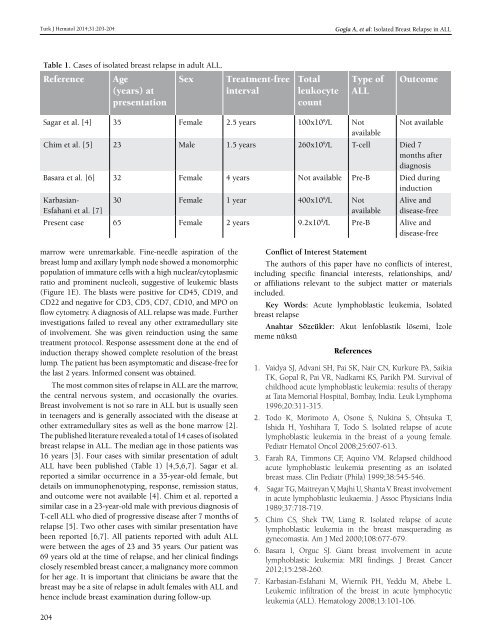Turkish Journal of Hematology Volume: 31 - Issue: 2
Create successful ePaper yourself
Turn your PDF publications into a flip-book with our unique Google optimized e-Paper software.
Turk J Hematol 2014;<strong>31</strong>:203-204<br />
Gogia A, et al: Isolated Breast Relapse in ALL<br />
Table 1. Cases <strong>of</strong> isolated breast relapse in adult ALL.<br />
Reference Age<br />
(years) at<br />
presentation<br />
Sex Treatment-free<br />
interval<br />
Total<br />
leukocyte<br />
count<br />
Type <strong>of</strong><br />
ALL<br />
Outcome<br />
Sagar et al. [4] 35 Female 2.5 years 100x10 9 /L Not Not available<br />
available<br />
Chim et al. [5] 23 Male 1.5 years 260x10 9 /L T-cell Died 7<br />
months after<br />
diagnosis<br />
Basara et al. [6] 32 Female 4 years Not available Pre-B Died during<br />
induction<br />
Karbasian-<br />
Esfahani et al. [7]<br />
30 Female 1 year 400x10 9 /L Not<br />
available<br />
Alive and<br />
disease-free<br />
Present case 65 Female 2 years 9.2x10 9 /L Pre-B Alive and<br />
disease-free<br />
marrow were unremarkable. Fine-needle aspiration <strong>of</strong> the<br />
breast lump and axillary lymph node showed a monomorphic<br />
population <strong>of</strong> immature cells with a high nuclear/cytoplasmic<br />
ratio and prominent nucleoli, suggestive <strong>of</strong> leukemic blasts<br />
(Figure 1E). The blasts were positive for CD45, CD19, and<br />
CD22 and negative for CD3, CD5, CD7, CD10, and MPO on<br />
flow cytometry. A diagnosis <strong>of</strong> ALL relapse was made. Further<br />
investigations failed to reveal any other extramedullary site<br />
<strong>of</strong> involvement. She was given reinduction using the same<br />
treatment protocol. Response assessment done at the end <strong>of</strong><br />
induction therapy showed complete resolution <strong>of</strong> the breast<br />
lump. The patient has been asymptomatic and disease-free for<br />
the last 2 years. Informed consent was obtained.<br />
The most common sites <strong>of</strong> relapse in ALL are the marrow,<br />
the central nervous system, and occasionally the ovaries.<br />
Breast involvement is not so rare in ALL but is usually seen<br />
in teenagers and is generally associated with the disease at<br />
other extramedullary sites as well as the bone marrow [2].<br />
The published literature revealed a total <strong>of</strong> 14 cases <strong>of</strong> isolated<br />
breast relapse in ALL. The median age in those patients was<br />
16 years [3]. Four cases with similar presentation <strong>of</strong> adult<br />
ALL have been published (Table 1) [4,5,6,7]. Sagar et al.<br />
reported a similar occurrence in a 35-year-old female, but<br />
details on immunophenotyping, response, remission status,<br />
and outcome were not available [4]. Chim et al. reported a<br />
similar case in a 23-year-old male with previous diagnosis <strong>of</strong><br />
T-cell ALL who died <strong>of</strong> progressive disease after 7 months <strong>of</strong><br />
relapse [5]. Two other cases with similar presentation have<br />
been reported [6,7]. All patients reported with adult ALL<br />
were between the ages <strong>of</strong> 23 and 35 years. Our patient was<br />
69 years old at the time <strong>of</strong> relapse, and her clinical findings<br />
closely resembled breast cancer, a malignancy more common<br />
for her age. It is important that clinicians be aware that the<br />
breast may be a site <strong>of</strong> relapse in adult females with ALL and<br />
hence include breast examination during follow-up.<br />
Conflict <strong>of</strong> Interest Statement<br />
The authors <strong>of</strong> this paper have no conflicts <strong>of</strong> interest,<br />
including specific financial interests, relationships, and/<br />
or affiliations relevant to the subject matter or materials<br />
included.<br />
Key Words: Acute lymphoblastic leukemia, Isolated<br />
breast relapse<br />
Anahtar Sözcükler: Akut lenfoblastik lösemi, İzole<br />
meme nüksü<br />
References<br />
1. Vaidya SJ, Advani SH, Pai SK, Nair CN, Kurkure PA, Saikia<br />
TK, Gopal R, Pai VR, Nadkarni KS, Parikh PM. Survival <strong>of</strong><br />
childhood acute lymphoblastic leukemia: results <strong>of</strong> therapy<br />
at Tata Memorial Hospital, Bombay, India. Leuk Lymphoma<br />
1996;20:<strong>31</strong>1-<strong>31</strong>5.<br />
2. Todo K, Morimoto A, Osone S, Nukina S, Ohtsuka T,<br />
Ishida H, Yoshihara T, Todo S. Isolated relapse <strong>of</strong> acute<br />
lymphoblastic leukemia in the breast <strong>of</strong> a young female.<br />
Pediatr Hematol Oncol 2008;25:607-613.<br />
3. Farah RA, Timmons CF, Aquino VM. Relapsed childhood<br />
acute lymphoblastic leukemia presenting as an isolated<br />
breast mass. Clin Pediatr (Phila) 1999;38:545-546.<br />
4. Sagar TG, Maitreyan V, Majhi U, Shanta V. Breast involvement<br />
in acute lymphoblastic leukaemia. J Assoc Physicians India<br />
1989;37:718-719.<br />
5. Chim CS, Shek TW, Liang R. Isolated relapse <strong>of</strong> acute<br />
lymphoblastic leukemia in the breast masquerading as<br />
gynecomastia. Am J Med 2000;108:677-679.<br />
6. Basara I, Orguc SJ. Giant breast involvement in acute<br />
lymphoblastic leukemia: MRI findings. J Breast Cancer<br />
2012;15:258-260.<br />
7. Karbasian-Esfahani M, Wiernik PH, Yeddu M, Abebe L.<br />
Leukemic infiltration <strong>of</strong> the breast in acute lymphocytic<br />
leukemia (ALL). <strong>Hematology</strong> 2008;13:101-106.<br />
204

















